McDonald's: A Study of Leadership, Management, and CSR Strategies
VerifiedAdded on 2024/06/03
|12
|2724
|55
Essay
AI Summary
This essay provides an overview of leadership and management roles within an organization, emphasizing their importance in achieving business objectives, particularly in the context of globalization and evolving cultural landscapes. Using McDonald's as a case study, the analysis identifies and explains the three organizational levels (corporate, divisional, and operating) and their responsibilities. It explores various leadership and management styles, assessing which styles McDonald's has adopted. Furthermore, the essay discusses the effects of globalization on the organization, including cultural diversity, earnings changes, and increased standards. Finally, it examines Corporate Social Responsibility (CSR) and reviews two CSR responses adopted by McDonald's, highlighting the company's efforts in environmental conservation and philanthropic endeavors to maintain stakeholder relationships and brand image.
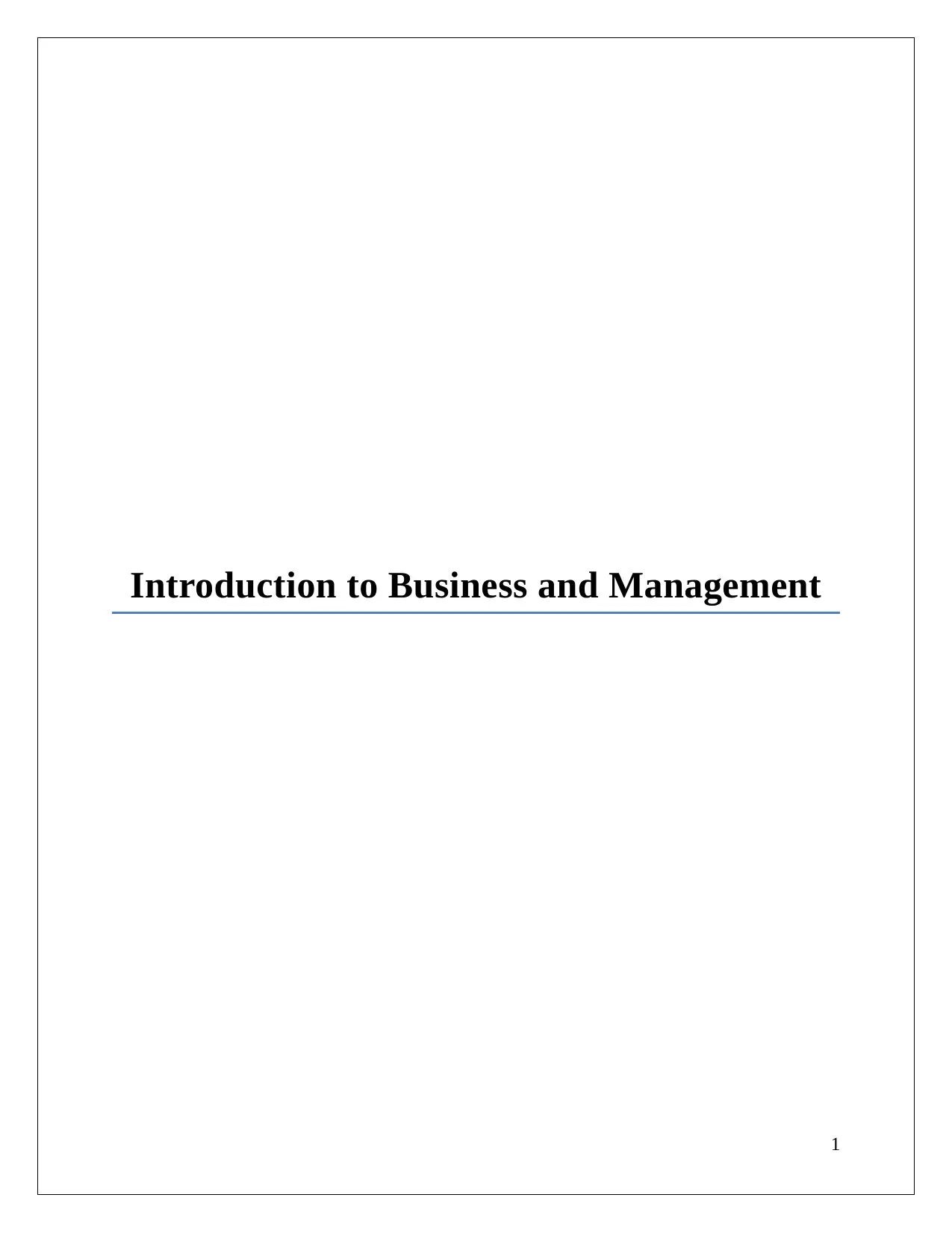
Introduction to Business and Management
1
1
Paraphrase This Document
Need a fresh take? Get an instant paraphrase of this document with our AI Paraphraser
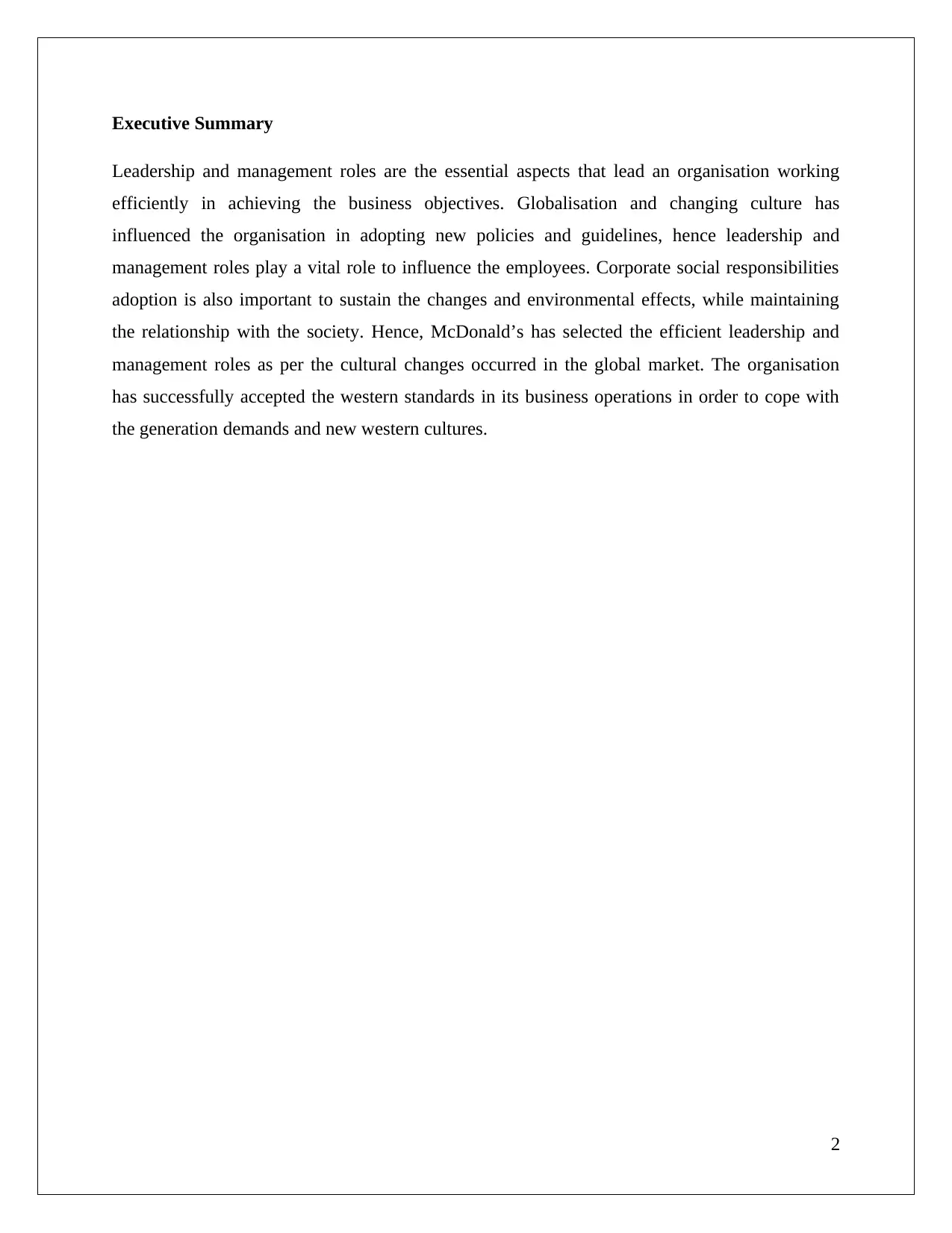
Executive Summary
Leadership and management roles are the essential aspects that lead an organisation working
efficiently in achieving the business objectives. Globalisation and changing culture has
influenced the organisation in adopting new policies and guidelines, hence leadership and
management roles play a vital role to influence the employees. Corporate social responsibilities
adoption is also important to sustain the changes and environmental effects, while maintaining
the relationship with the society. Hence, McDonald’s has selected the efficient leadership and
management roles as per the cultural changes occurred in the global market. The organisation
has successfully accepted the western standards in its business operations in order to cope with
the generation demands and new western cultures.
2
Leadership and management roles are the essential aspects that lead an organisation working
efficiently in achieving the business objectives. Globalisation and changing culture has
influenced the organisation in adopting new policies and guidelines, hence leadership and
management roles play a vital role to influence the employees. Corporate social responsibilities
adoption is also important to sustain the changes and environmental effects, while maintaining
the relationship with the society. Hence, McDonald’s has selected the efficient leadership and
management roles as per the cultural changes occurred in the global market. The organisation
has successfully accepted the western standards in its business operations in order to cope with
the generation demands and new western cultures.
2
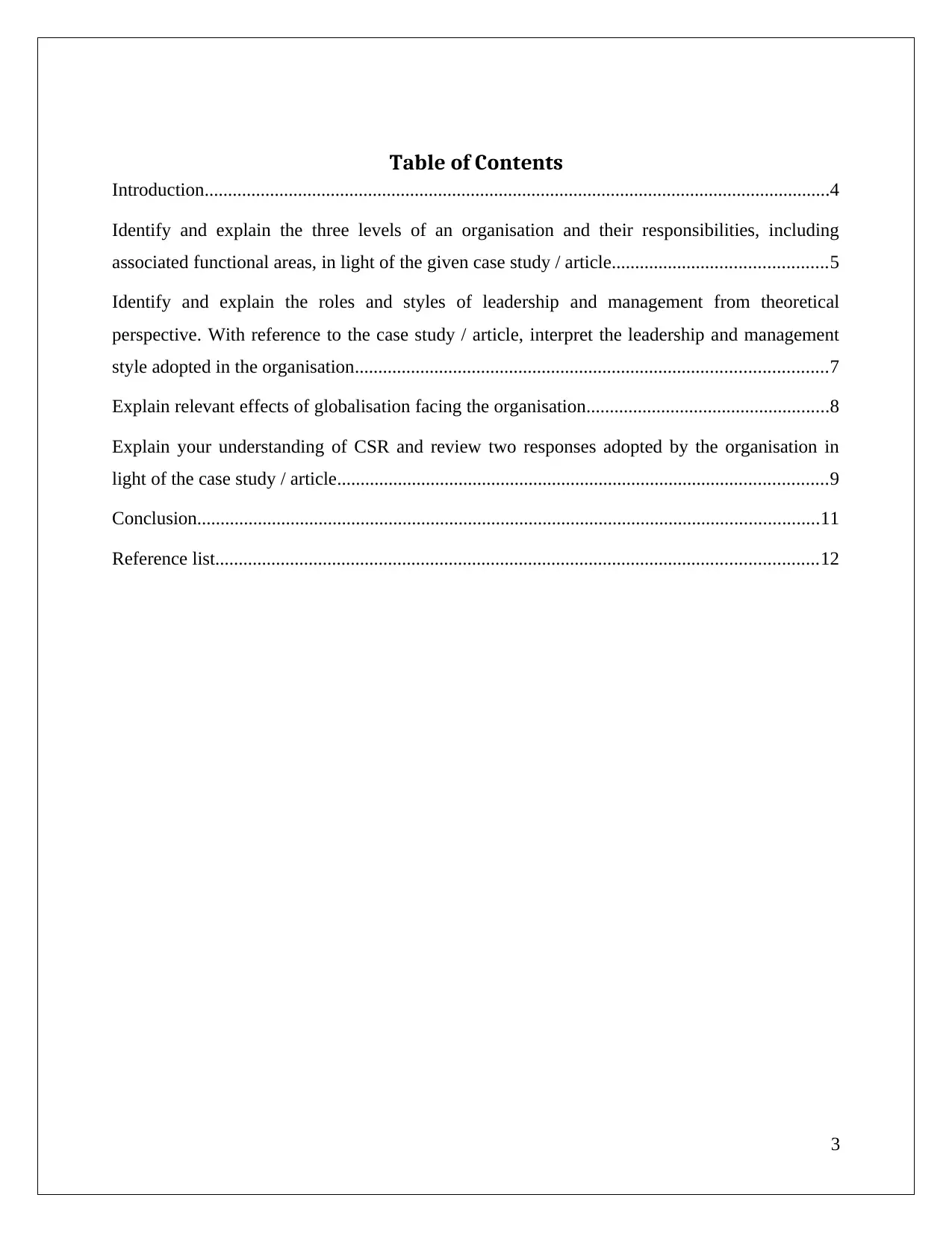
Table of Contents
Introduction......................................................................................................................................4
Identify and explain the three levels of an organisation and their responsibilities, including
associated functional areas, in light of the given case study / article..............................................5
Identify and explain the roles and styles of leadership and management from theoretical
perspective. With reference to the case study / article, interpret the leadership and management
style adopted in the organisation.....................................................................................................7
Explain relevant effects of globalisation facing the organisation....................................................8
Explain your understanding of CSR and review two responses adopted by the organisation in
light of the case study / article.........................................................................................................9
Conclusion.....................................................................................................................................11
Reference list.................................................................................................................................12
3
Introduction......................................................................................................................................4
Identify and explain the three levels of an organisation and their responsibilities, including
associated functional areas, in light of the given case study / article..............................................5
Identify and explain the roles and styles of leadership and management from theoretical
perspective. With reference to the case study / article, interpret the leadership and management
style adopted in the organisation.....................................................................................................7
Explain relevant effects of globalisation facing the organisation....................................................8
Explain your understanding of CSR and review two responses adopted by the organisation in
light of the case study / article.........................................................................................................9
Conclusion.....................................................................................................................................11
Reference list.................................................................................................................................12
3
⊘ This is a preview!⊘
Do you want full access?
Subscribe today to unlock all pages.

Trusted by 1+ million students worldwide
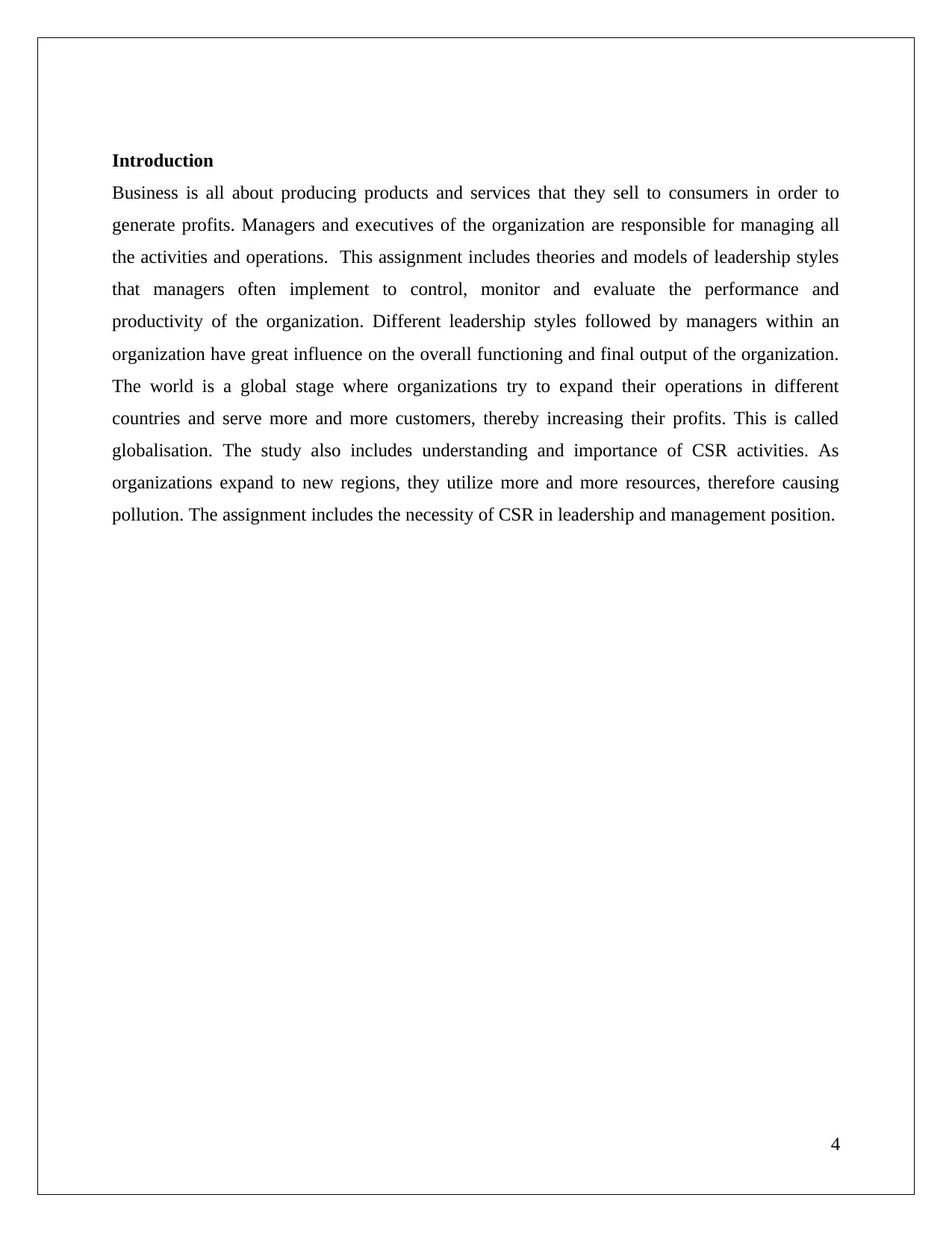
Introduction
Business is all about producing products and services that they sell to consumers in order to
generate profits. Managers and executives of the organization are responsible for managing all
the activities and operations. This assignment includes theories and models of leadership styles
that managers often implement to control, monitor and evaluate the performance and
productivity of the organization. Different leadership styles followed by managers within an
organization have great influence on the overall functioning and final output of the organization.
The world is a global stage where organizations try to expand their operations in different
countries and serve more and more customers, thereby increasing their profits. This is called
globalisation. The study also includes understanding and importance of CSR activities. As
organizations expand to new regions, they utilize more and more resources, therefore causing
pollution. The assignment includes the necessity of CSR in leadership and management position.
4
Business is all about producing products and services that they sell to consumers in order to
generate profits. Managers and executives of the organization are responsible for managing all
the activities and operations. This assignment includes theories and models of leadership styles
that managers often implement to control, monitor and evaluate the performance and
productivity of the organization. Different leadership styles followed by managers within an
organization have great influence on the overall functioning and final output of the organization.
The world is a global stage where organizations try to expand their operations in different
countries and serve more and more customers, thereby increasing their profits. This is called
globalisation. The study also includes understanding and importance of CSR activities. As
organizations expand to new regions, they utilize more and more resources, therefore causing
pollution. The assignment includes the necessity of CSR in leadership and management position.
4
Paraphrase This Document
Need a fresh take? Get an instant paraphrase of this document with our AI Paraphraser
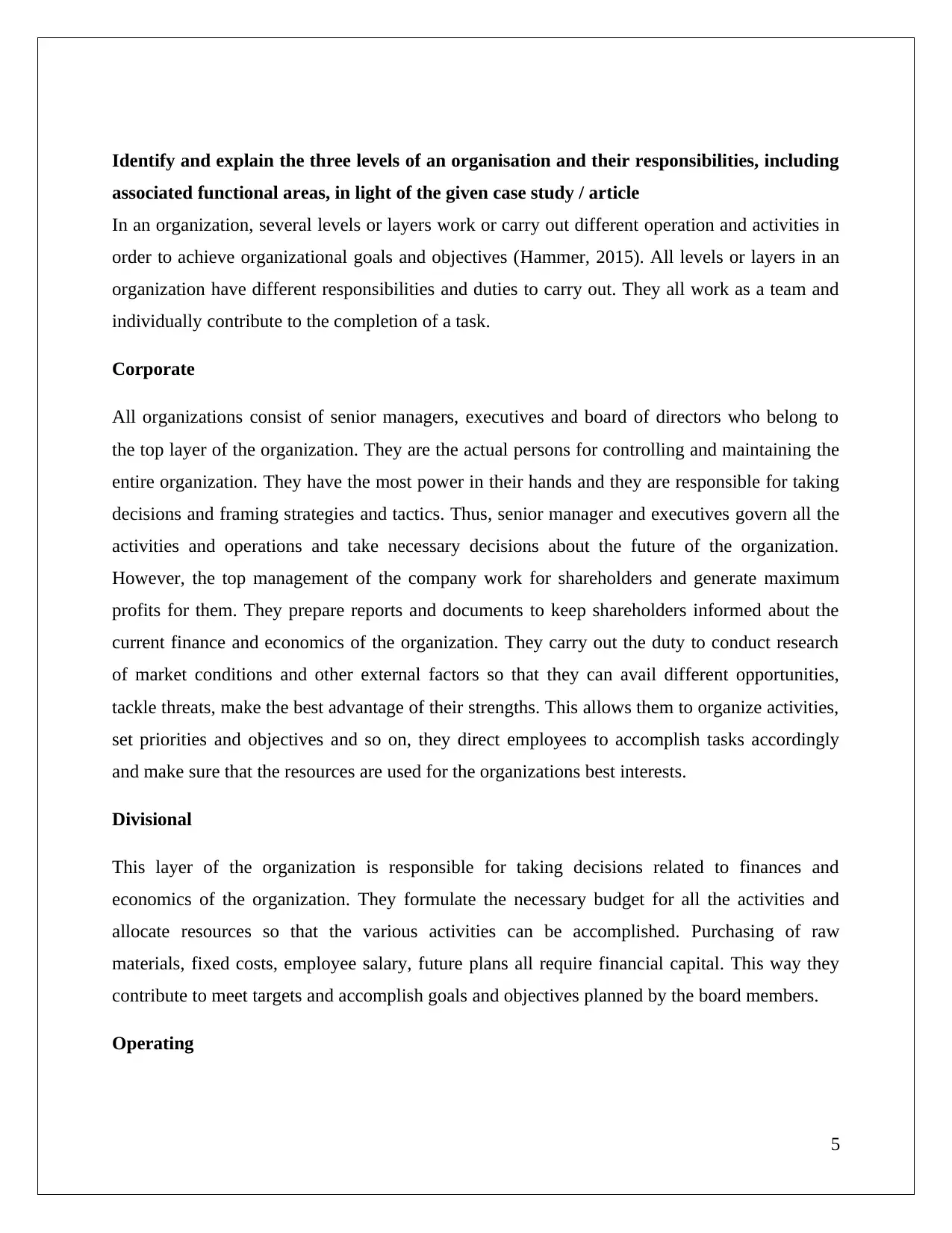
Identify and explain the three levels of an organisation and their responsibilities, including
associated functional areas, in light of the given case study / article
In an organization, several levels or layers work or carry out different operation and activities in
order to achieve organizational goals and objectives (Hammer, 2015). All levels or layers in an
organization have different responsibilities and duties to carry out. They all work as a team and
individually contribute to the completion of a task.
Corporate
All organizations consist of senior managers, executives and board of directors who belong to
the top layer of the organization. They are the actual persons for controlling and maintaining the
entire organization. They have the most power in their hands and they are responsible for taking
decisions and framing strategies and tactics. Thus, senior manager and executives govern all the
activities and operations and take necessary decisions about the future of the organization.
However, the top management of the company work for shareholders and generate maximum
profits for them. They prepare reports and documents to keep shareholders informed about the
current finance and economics of the organization. They carry out the duty to conduct research
of market conditions and other external factors so that they can avail different opportunities,
tackle threats, make the best advantage of their strengths. This allows them to organize activities,
set priorities and objectives and so on, they direct employees to accomplish tasks accordingly
and make sure that the resources are used for the organizations best interests.
Divisional
This layer of the organization is responsible for taking decisions related to finances and
economics of the organization. They formulate the necessary budget for all the activities and
allocate resources so that the various activities can be accomplished. Purchasing of raw
materials, fixed costs, employee salary, future plans all require financial capital. This way they
contribute to meet targets and accomplish goals and objectives planned by the board members.
Operating
5
associated functional areas, in light of the given case study / article
In an organization, several levels or layers work or carry out different operation and activities in
order to achieve organizational goals and objectives (Hammer, 2015). All levels or layers in an
organization have different responsibilities and duties to carry out. They all work as a team and
individually contribute to the completion of a task.
Corporate
All organizations consist of senior managers, executives and board of directors who belong to
the top layer of the organization. They are the actual persons for controlling and maintaining the
entire organization. They have the most power in their hands and they are responsible for taking
decisions and framing strategies and tactics. Thus, senior manager and executives govern all the
activities and operations and take necessary decisions about the future of the organization.
However, the top management of the company work for shareholders and generate maximum
profits for them. They prepare reports and documents to keep shareholders informed about the
current finance and economics of the organization. They carry out the duty to conduct research
of market conditions and other external factors so that they can avail different opportunities,
tackle threats, make the best advantage of their strengths. This allows them to organize activities,
set priorities and objectives and so on, they direct employees to accomplish tasks accordingly
and make sure that the resources are used for the organizations best interests.
Divisional
This layer of the organization is responsible for taking decisions related to finances and
economics of the organization. They formulate the necessary budget for all the activities and
allocate resources so that the various activities can be accomplished. Purchasing of raw
materials, fixed costs, employee salary, future plans all require financial capital. This way they
contribute to meet targets and accomplish goals and objectives planned by the board members.
Operating
5
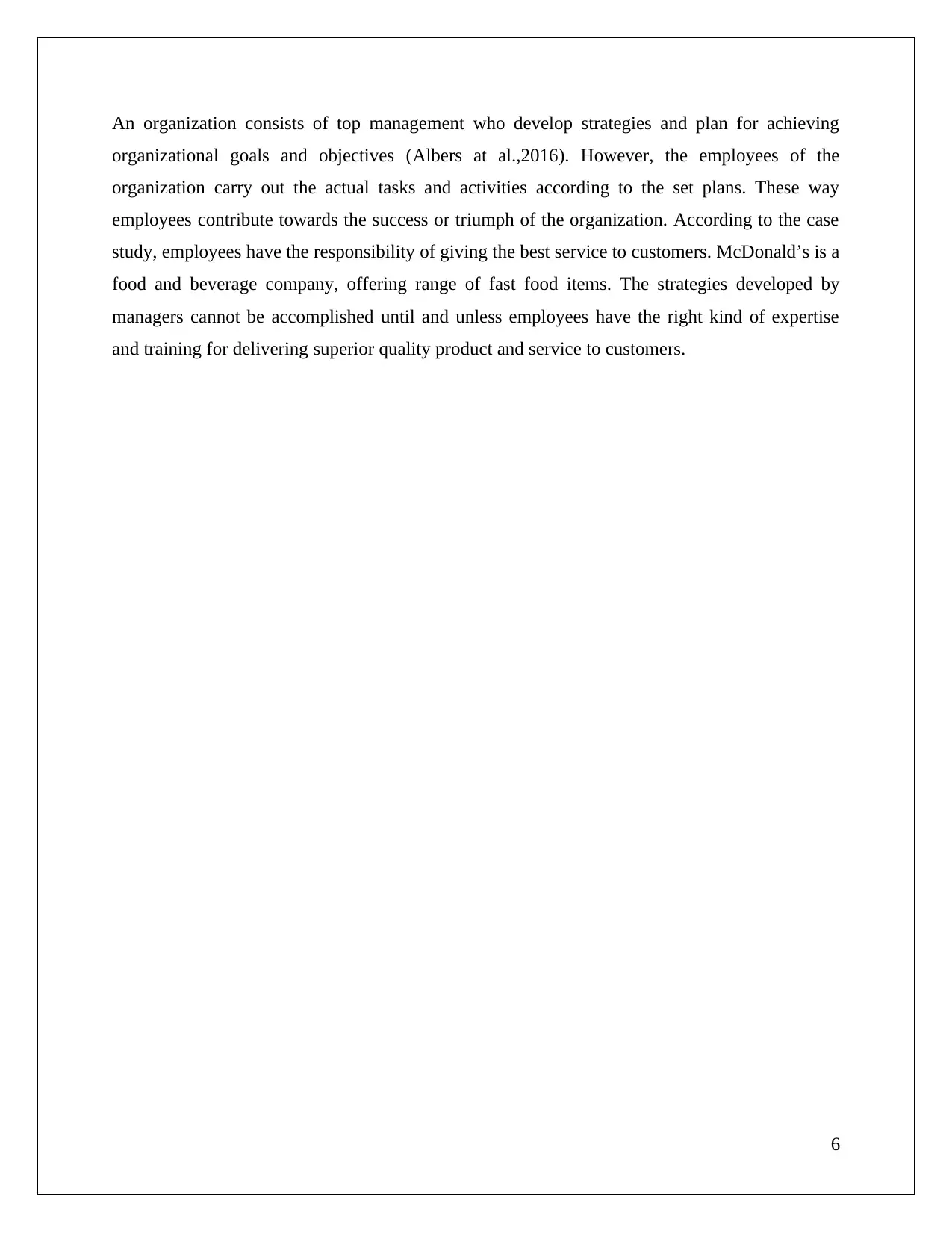
An organization consists of top management who develop strategies and plan for achieving
organizational goals and objectives (Albers at al.,2016). However, the employees of the
organization carry out the actual tasks and activities according to the set plans. These way
employees contribute towards the success or triumph of the organization. According to the case
study, employees have the responsibility of giving the best service to customers. McDonald’s is a
food and beverage company, offering range of fast food items. The strategies developed by
managers cannot be accomplished until and unless employees have the right kind of expertise
and training for delivering superior quality product and service to customers.
6
organizational goals and objectives (Albers at al.,2016). However, the employees of the
organization carry out the actual tasks and activities according to the set plans. These way
employees contribute towards the success or triumph of the organization. According to the case
study, employees have the responsibility of giving the best service to customers. McDonald’s is a
food and beverage company, offering range of fast food items. The strategies developed by
managers cannot be accomplished until and unless employees have the right kind of expertise
and training for delivering superior quality product and service to customers.
6
⊘ This is a preview!⊘
Do you want full access?
Subscribe today to unlock all pages.

Trusted by 1+ million students worldwide
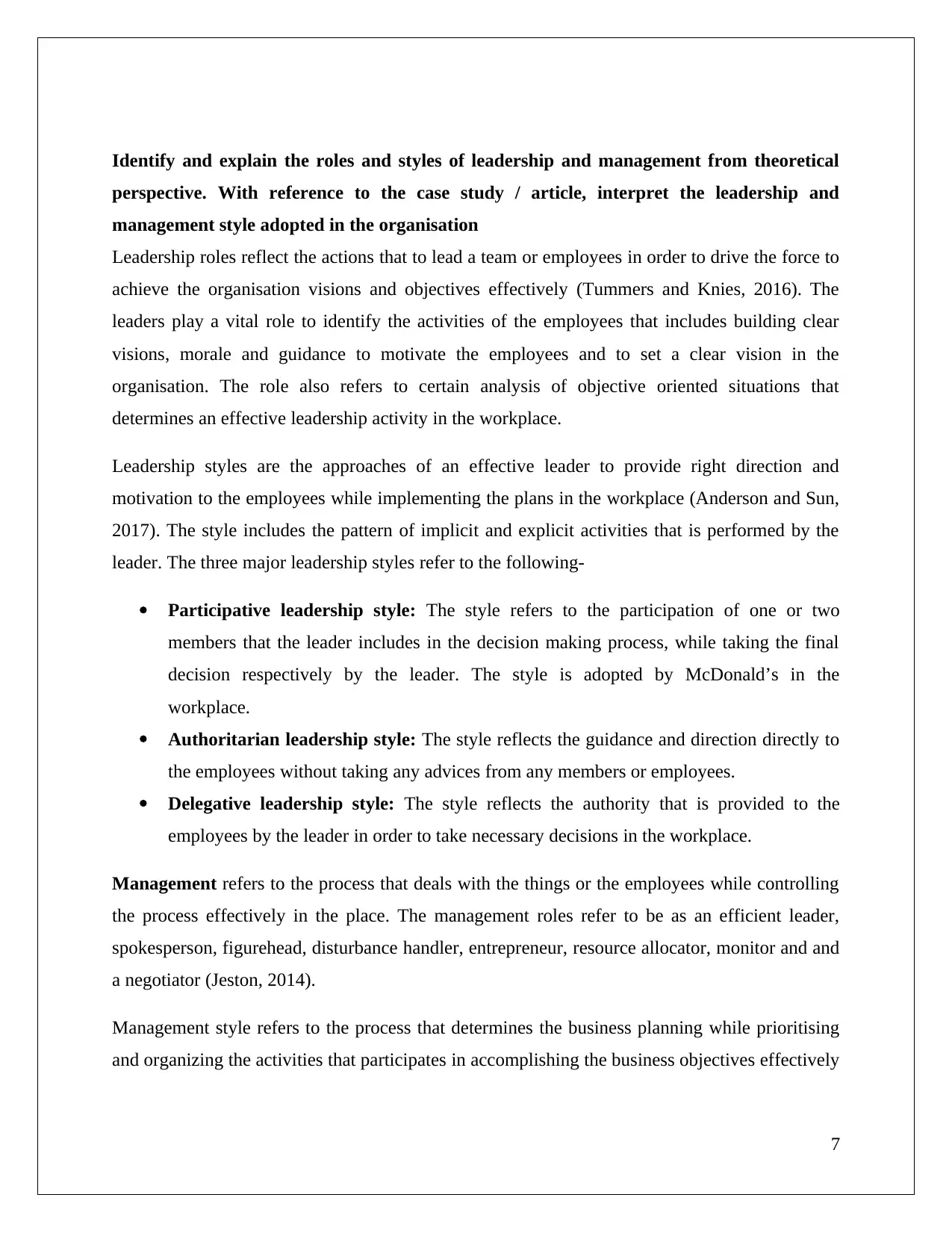
Identify and explain the roles and styles of leadership and management from theoretical
perspective. With reference to the case study / article, interpret the leadership and
management style adopted in the organisation
Leadership roles reflect the actions that to lead a team or employees in order to drive the force to
achieve the organisation visions and objectives effectively (Tummers and Knies, 2016). The
leaders play a vital role to identify the activities of the employees that includes building clear
visions, morale and guidance to motivate the employees and to set a clear vision in the
organisation. The role also refers to certain analysis of objective oriented situations that
determines an effective leadership activity in the workplace.
Leadership styles are the approaches of an effective leader to provide right direction and
motivation to the employees while implementing the plans in the workplace (Anderson and Sun,
2017). The style includes the pattern of implicit and explicit activities that is performed by the
leader. The three major leadership styles refer to the following-
Participative leadership style: The style refers to the participation of one or two
members that the leader includes in the decision making process, while taking the final
decision respectively by the leader. The style is adopted by McDonald’s in the
workplace.
Authoritarian leadership style: The style reflects the guidance and direction directly to
the employees without taking any advices from any members or employees.
Delegative leadership style: The style reflects the authority that is provided to the
employees by the leader in order to take necessary decisions in the workplace.
Management refers to the process that deals with the things or the employees while controlling
the process effectively in the place. The management roles refer to be as an efficient leader,
spokesperson, figurehead, disturbance handler, entrepreneur, resource allocator, monitor and and
a negotiator (Jeston, 2014).
Management style refers to the process that determines the business planning while prioritising
and organizing the activities that participates in accomplishing the business objectives effectively
7
perspective. With reference to the case study / article, interpret the leadership and
management style adopted in the organisation
Leadership roles reflect the actions that to lead a team or employees in order to drive the force to
achieve the organisation visions and objectives effectively (Tummers and Knies, 2016). The
leaders play a vital role to identify the activities of the employees that includes building clear
visions, morale and guidance to motivate the employees and to set a clear vision in the
organisation. The role also refers to certain analysis of objective oriented situations that
determines an effective leadership activity in the workplace.
Leadership styles are the approaches of an effective leader to provide right direction and
motivation to the employees while implementing the plans in the workplace (Anderson and Sun,
2017). The style includes the pattern of implicit and explicit activities that is performed by the
leader. The three major leadership styles refer to the following-
Participative leadership style: The style refers to the participation of one or two
members that the leader includes in the decision making process, while taking the final
decision respectively by the leader. The style is adopted by McDonald’s in the
workplace.
Authoritarian leadership style: The style reflects the guidance and direction directly to
the employees without taking any advices from any members or employees.
Delegative leadership style: The style reflects the authority that is provided to the
employees by the leader in order to take necessary decisions in the workplace.
Management refers to the process that deals with the things or the employees while controlling
the process effectively in the place. The management roles refer to be as an efficient leader,
spokesperson, figurehead, disturbance handler, entrepreneur, resource allocator, monitor and and
a negotiator (Jeston, 2014).
Management style refers to the process that determines the business planning while prioritising
and organizing the activities that participates in accomplishing the business objectives effectively
7
Paraphrase This Document
Need a fresh take? Get an instant paraphrase of this document with our AI Paraphraser
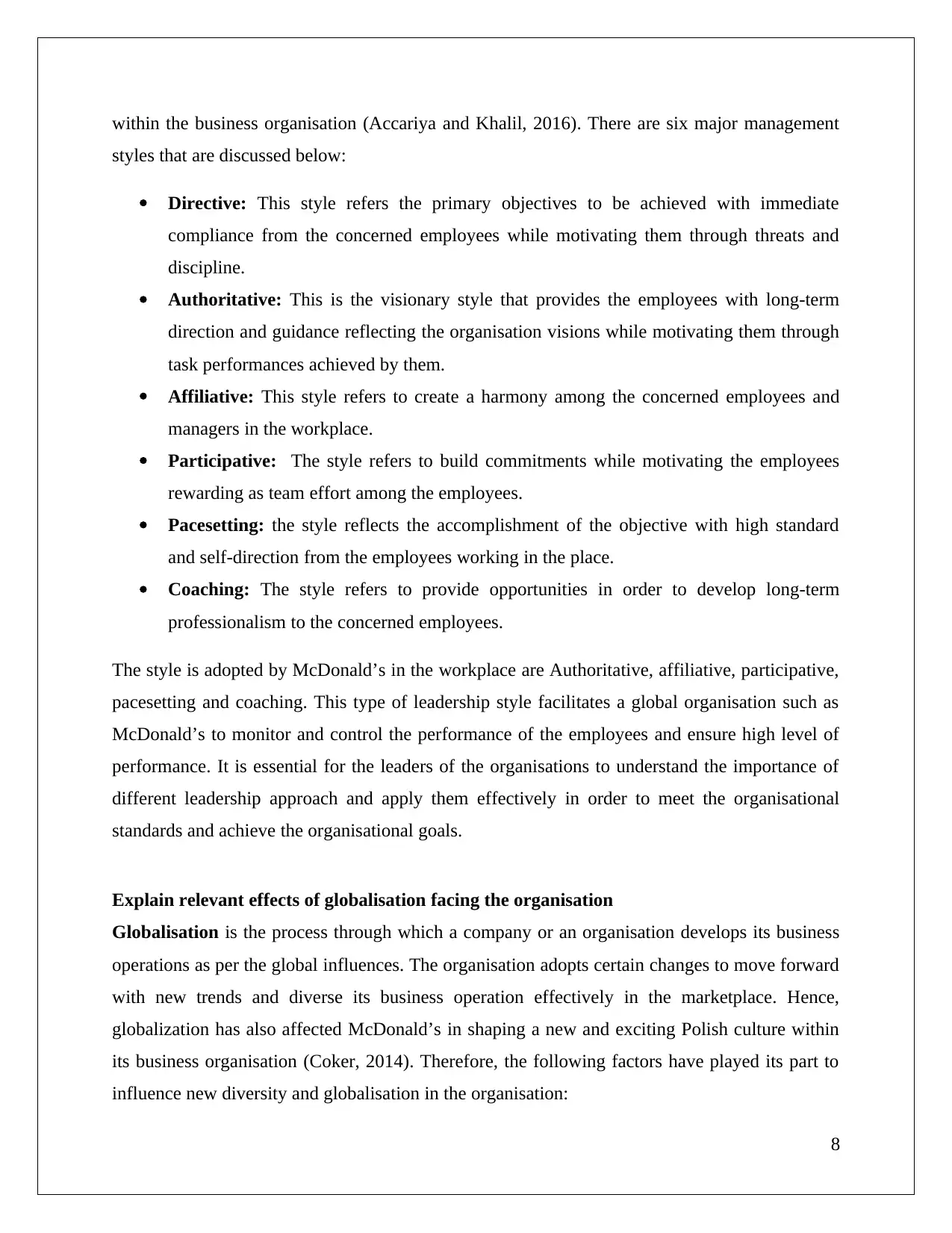
within the business organisation (Accariya and Khalil, 2016). There are six major management
styles that are discussed below:
Directive: This style refers the primary objectives to be achieved with immediate
compliance from the concerned employees while motivating them through threats and
discipline.
Authoritative: This is the visionary style that provides the employees with long-term
direction and guidance reflecting the organisation visions while motivating them through
task performances achieved by them.
Affiliative: This style refers to create a harmony among the concerned employees and
managers in the workplace.
Participative: The style refers to build commitments while motivating the employees
rewarding as team effort among the employees.
Pacesetting: the style reflects the accomplishment of the objective with high standard
and self-direction from the employees working in the place.
Coaching: The style refers to provide opportunities in order to develop long-term
professionalism to the concerned employees.
The style is adopted by McDonald’s in the workplace are Authoritative, affiliative, participative,
pacesetting and coaching. This type of leadership style facilitates a global organisation such as
McDonald’s to monitor and control the performance of the employees and ensure high level of
performance. It is essential for the leaders of the organisations to understand the importance of
different leadership approach and apply them effectively in order to meet the organisational
standards and achieve the organisational goals.
Explain relevant effects of globalisation facing the organisation
Globalisation is the process through which a company or an organisation develops its business
operations as per the global influences. The organisation adopts certain changes to move forward
with new trends and diverse its business operation effectively in the marketplace. Hence,
globalization has also affected McDonald’s in shaping a new and exciting Polish culture within
its business organisation (Coker, 2014). Therefore, the following factors have played its part to
influence new diversity and globalisation in the organisation:
8
styles that are discussed below:
Directive: This style refers the primary objectives to be achieved with immediate
compliance from the concerned employees while motivating them through threats and
discipline.
Authoritative: This is the visionary style that provides the employees with long-term
direction and guidance reflecting the organisation visions while motivating them through
task performances achieved by them.
Affiliative: This style refers to create a harmony among the concerned employees and
managers in the workplace.
Participative: The style refers to build commitments while motivating the employees
rewarding as team effort among the employees.
Pacesetting: the style reflects the accomplishment of the objective with high standard
and self-direction from the employees working in the place.
Coaching: The style refers to provide opportunities in order to develop long-term
professionalism to the concerned employees.
The style is adopted by McDonald’s in the workplace are Authoritative, affiliative, participative,
pacesetting and coaching. This type of leadership style facilitates a global organisation such as
McDonald’s to monitor and control the performance of the employees and ensure high level of
performance. It is essential for the leaders of the organisations to understand the importance of
different leadership approach and apply them effectively in order to meet the organisational
standards and achieve the organisational goals.
Explain relevant effects of globalisation facing the organisation
Globalisation is the process through which a company or an organisation develops its business
operations as per the global influences. The organisation adopts certain changes to move forward
with new trends and diverse its business operation effectively in the marketplace. Hence,
globalization has also affected McDonald’s in shaping a new and exciting Polish culture within
its business organisation (Coker, 2014). Therefore, the following factors have played its part to
influence new diversity and globalisation in the organisation:
8
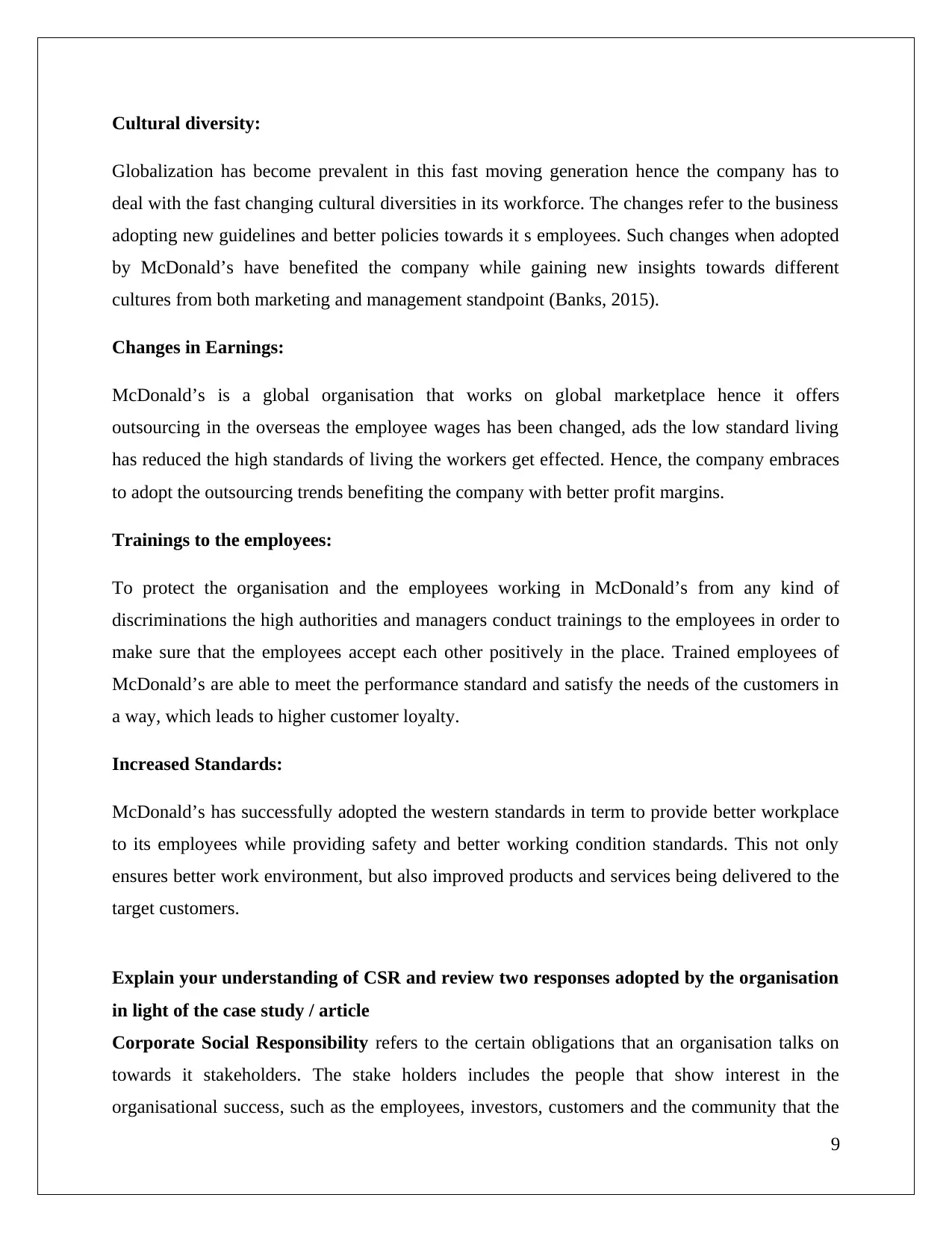
Cultural diversity:
Globalization has become prevalent in this fast moving generation hence the company has to
deal with the fast changing cultural diversities in its workforce. The changes refer to the business
adopting new guidelines and better policies towards it s employees. Such changes when adopted
by McDonald’s have benefited the company while gaining new insights towards different
cultures from both marketing and management standpoint (Banks, 2015).
Changes in Earnings:
McDonald’s is a global organisation that works on global marketplace hence it offers
outsourcing in the overseas the employee wages has been changed, ads the low standard living
has reduced the high standards of living the workers get effected. Hence, the company embraces
to adopt the outsourcing trends benefiting the company with better profit margins.
Trainings to the employees:
To protect the organisation and the employees working in McDonald’s from any kind of
discriminations the high authorities and managers conduct trainings to the employees in order to
make sure that the employees accept each other positively in the place. Trained employees of
McDonald’s are able to meet the performance standard and satisfy the needs of the customers in
a way, which leads to higher customer loyalty.
Increased Standards:
McDonald’s has successfully adopted the western standards in term to provide better workplace
to its employees while providing safety and better working condition standards. This not only
ensures better work environment, but also improved products and services being delivered to the
target customers.
Explain your understanding of CSR and review two responses adopted by the organisation
in light of the case study / article
Corporate Social Responsibility refers to the certain obligations that an organisation talks on
towards it stakeholders. The stake holders includes the people that show interest in the
organisational success, such as the employees, investors, customers and the community that the
9
Globalization has become prevalent in this fast moving generation hence the company has to
deal with the fast changing cultural diversities in its workforce. The changes refer to the business
adopting new guidelines and better policies towards it s employees. Such changes when adopted
by McDonald’s have benefited the company while gaining new insights towards different
cultures from both marketing and management standpoint (Banks, 2015).
Changes in Earnings:
McDonald’s is a global organisation that works on global marketplace hence it offers
outsourcing in the overseas the employee wages has been changed, ads the low standard living
has reduced the high standards of living the workers get effected. Hence, the company embraces
to adopt the outsourcing trends benefiting the company with better profit margins.
Trainings to the employees:
To protect the organisation and the employees working in McDonald’s from any kind of
discriminations the high authorities and managers conduct trainings to the employees in order to
make sure that the employees accept each other positively in the place. Trained employees of
McDonald’s are able to meet the performance standard and satisfy the needs of the customers in
a way, which leads to higher customer loyalty.
Increased Standards:
McDonald’s has successfully adopted the western standards in term to provide better workplace
to its employees while providing safety and better working condition standards. This not only
ensures better work environment, but also improved products and services being delivered to the
target customers.
Explain your understanding of CSR and review two responses adopted by the organisation
in light of the case study / article
Corporate Social Responsibility refers to the certain obligations that an organisation talks on
towards it stakeholders. The stake holders includes the people that show interest in the
organisational success, such as the employees, investors, customers and the community that the
9
⊘ This is a preview!⊘
Do you want full access?
Subscribe today to unlock all pages.

Trusted by 1+ million students worldwide
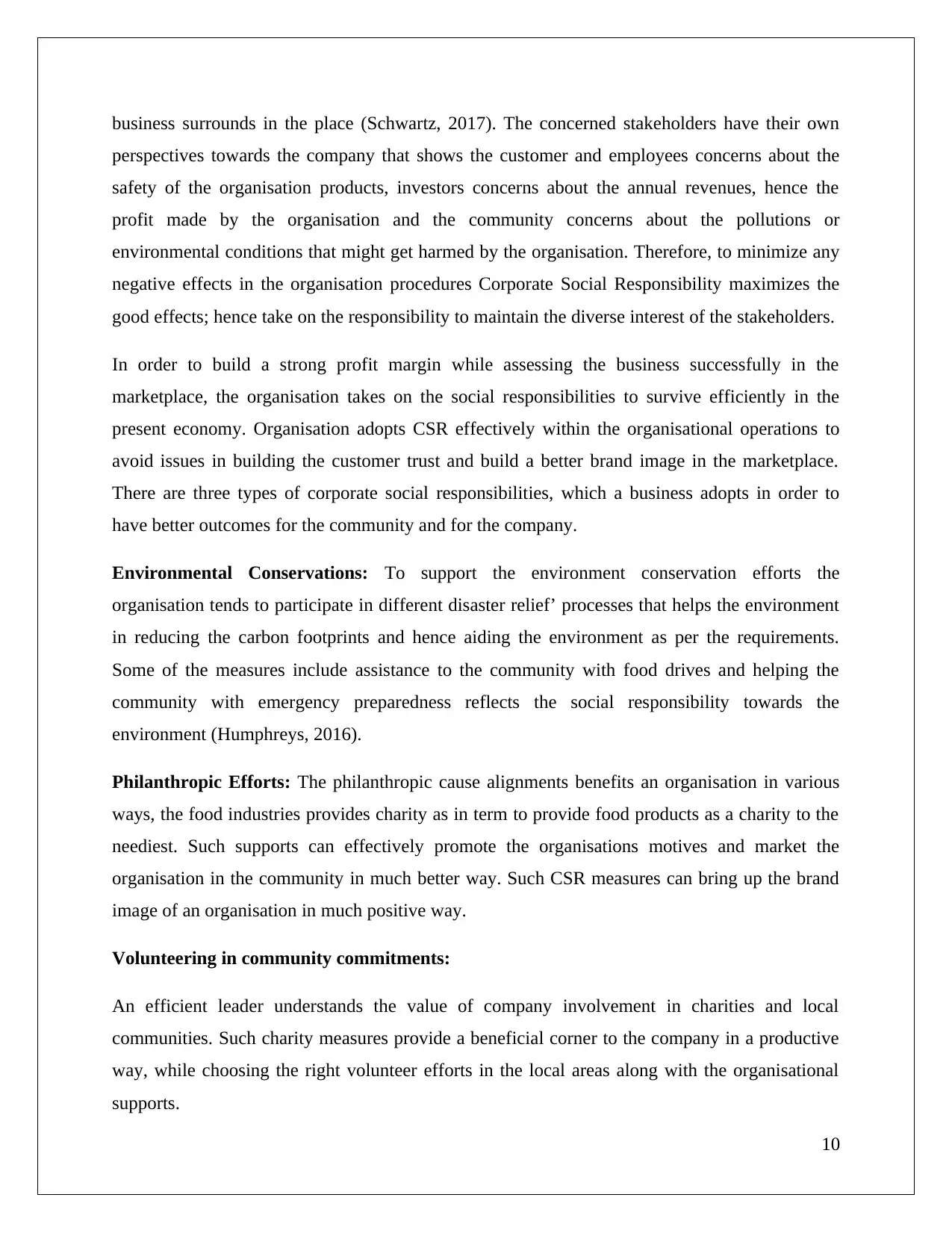
business surrounds in the place (Schwartz, 2017). The concerned stakeholders have their own
perspectives towards the company that shows the customer and employees concerns about the
safety of the organisation products, investors concerns about the annual revenues, hence the
profit made by the organisation and the community concerns about the pollutions or
environmental conditions that might get harmed by the organisation. Therefore, to minimize any
negative effects in the organisation procedures Corporate Social Responsibility maximizes the
good effects; hence take on the responsibility to maintain the diverse interest of the stakeholders.
In order to build a strong profit margin while assessing the business successfully in the
marketplace, the organisation takes on the social responsibilities to survive efficiently in the
present economy. Organisation adopts CSR effectively within the organisational operations to
avoid issues in building the customer trust and build a better brand image in the marketplace.
There are three types of corporate social responsibilities, which a business adopts in order to
have better outcomes for the community and for the company.
Environmental Conservations: To support the environment conservation efforts the
organisation tends to participate in different disaster relief’ processes that helps the environment
in reducing the carbon footprints and hence aiding the environment as per the requirements.
Some of the measures include assistance to the community with food drives and helping the
community with emergency preparedness reflects the social responsibility towards the
environment (Humphreys, 2016).
Philanthropic Efforts: The philanthropic cause alignments benefits an organisation in various
ways, the food industries provides charity as in term to provide food products as a charity to the
neediest. Such supports can effectively promote the organisations motives and market the
organisation in the community in much better way. Such CSR measures can bring up the brand
image of an organisation in much positive way.
Volunteering in community commitments:
An efficient leader understands the value of company involvement in charities and local
communities. Such charity measures provide a beneficial corner to the company in a productive
way, while choosing the right volunteer efforts in the local areas along with the organisational
supports.
10
perspectives towards the company that shows the customer and employees concerns about the
safety of the organisation products, investors concerns about the annual revenues, hence the
profit made by the organisation and the community concerns about the pollutions or
environmental conditions that might get harmed by the organisation. Therefore, to minimize any
negative effects in the organisation procedures Corporate Social Responsibility maximizes the
good effects; hence take on the responsibility to maintain the diverse interest of the stakeholders.
In order to build a strong profit margin while assessing the business successfully in the
marketplace, the organisation takes on the social responsibilities to survive efficiently in the
present economy. Organisation adopts CSR effectively within the organisational operations to
avoid issues in building the customer trust and build a better brand image in the marketplace.
There are three types of corporate social responsibilities, which a business adopts in order to
have better outcomes for the community and for the company.
Environmental Conservations: To support the environment conservation efforts the
organisation tends to participate in different disaster relief’ processes that helps the environment
in reducing the carbon footprints and hence aiding the environment as per the requirements.
Some of the measures include assistance to the community with food drives and helping the
community with emergency preparedness reflects the social responsibility towards the
environment (Humphreys, 2016).
Philanthropic Efforts: The philanthropic cause alignments benefits an organisation in various
ways, the food industries provides charity as in term to provide food products as a charity to the
neediest. Such supports can effectively promote the organisations motives and market the
organisation in the community in much better way. Such CSR measures can bring up the brand
image of an organisation in much positive way.
Volunteering in community commitments:
An efficient leader understands the value of company involvement in charities and local
communities. Such charity measures provide a beneficial corner to the company in a productive
way, while choosing the right volunteer efforts in the local areas along with the organisational
supports.
10
Paraphrase This Document
Need a fresh take? Get an instant paraphrase of this document with our AI Paraphraser
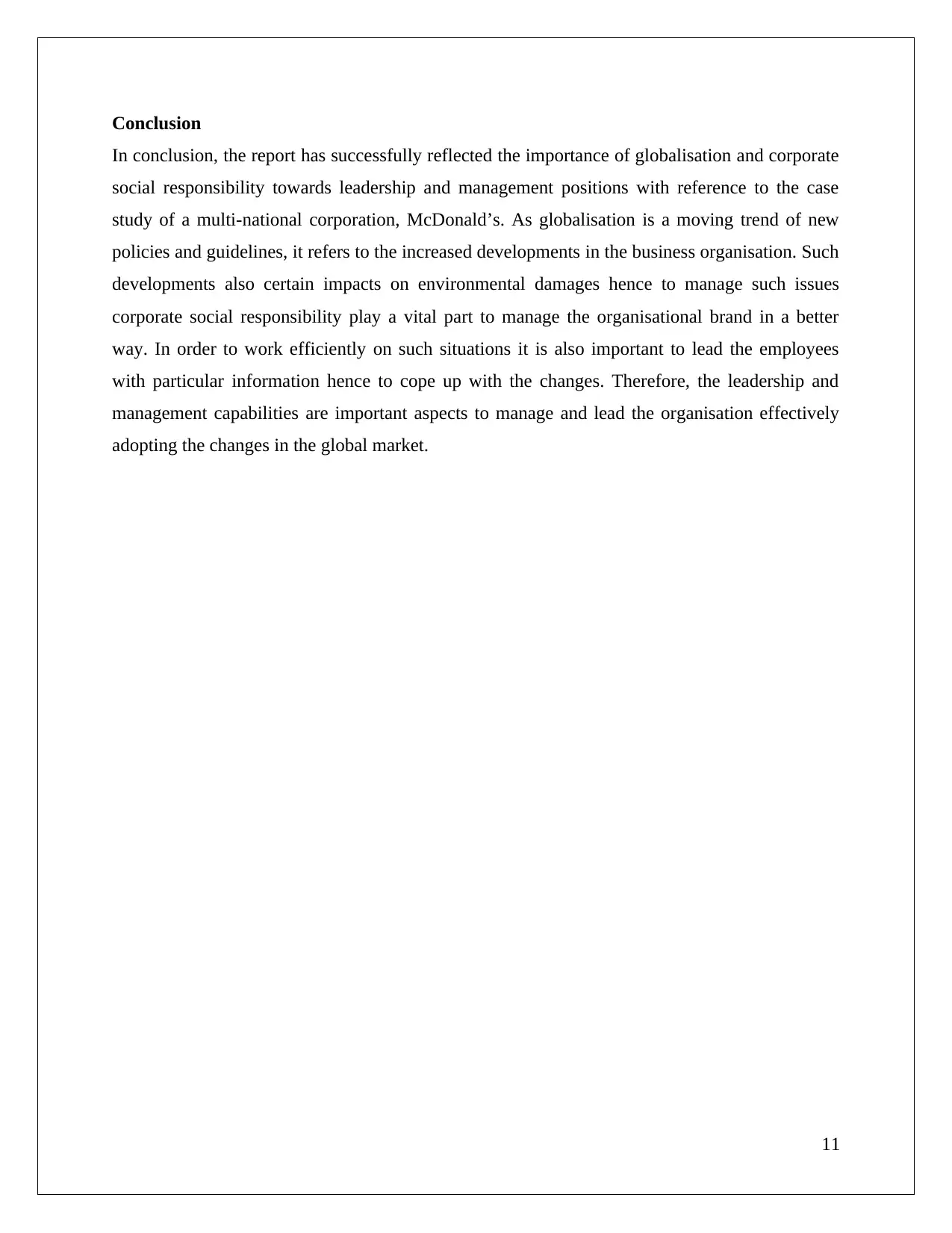
Conclusion
In conclusion, the report has successfully reflected the importance of globalisation and corporate
social responsibility towards leadership and management positions with reference to the case
study of a multi-national corporation, McDonald’s. As globalisation is a moving trend of new
policies and guidelines, it refers to the increased developments in the business organisation. Such
developments also certain impacts on environmental damages hence to manage such issues
corporate social responsibility play a vital part to manage the organisational brand in a better
way. In order to work efficiently on such situations it is also important to lead the employees
with particular information hence to cope up with the changes. Therefore, the leadership and
management capabilities are important aspects to manage and lead the organisation effectively
adopting the changes in the global market.
11
In conclusion, the report has successfully reflected the importance of globalisation and corporate
social responsibility towards leadership and management positions with reference to the case
study of a multi-national corporation, McDonald’s. As globalisation is a moving trend of new
policies and guidelines, it refers to the increased developments in the business organisation. Such
developments also certain impacts on environmental damages hence to manage such issues
corporate social responsibility play a vital part to manage the organisational brand in a better
way. In order to work efficiently on such situations it is also important to lead the employees
with particular information hence to cope up with the changes. Therefore, the leadership and
management capabilities are important aspects to manage and lead the organisation effectively
adopting the changes in the global market.
11
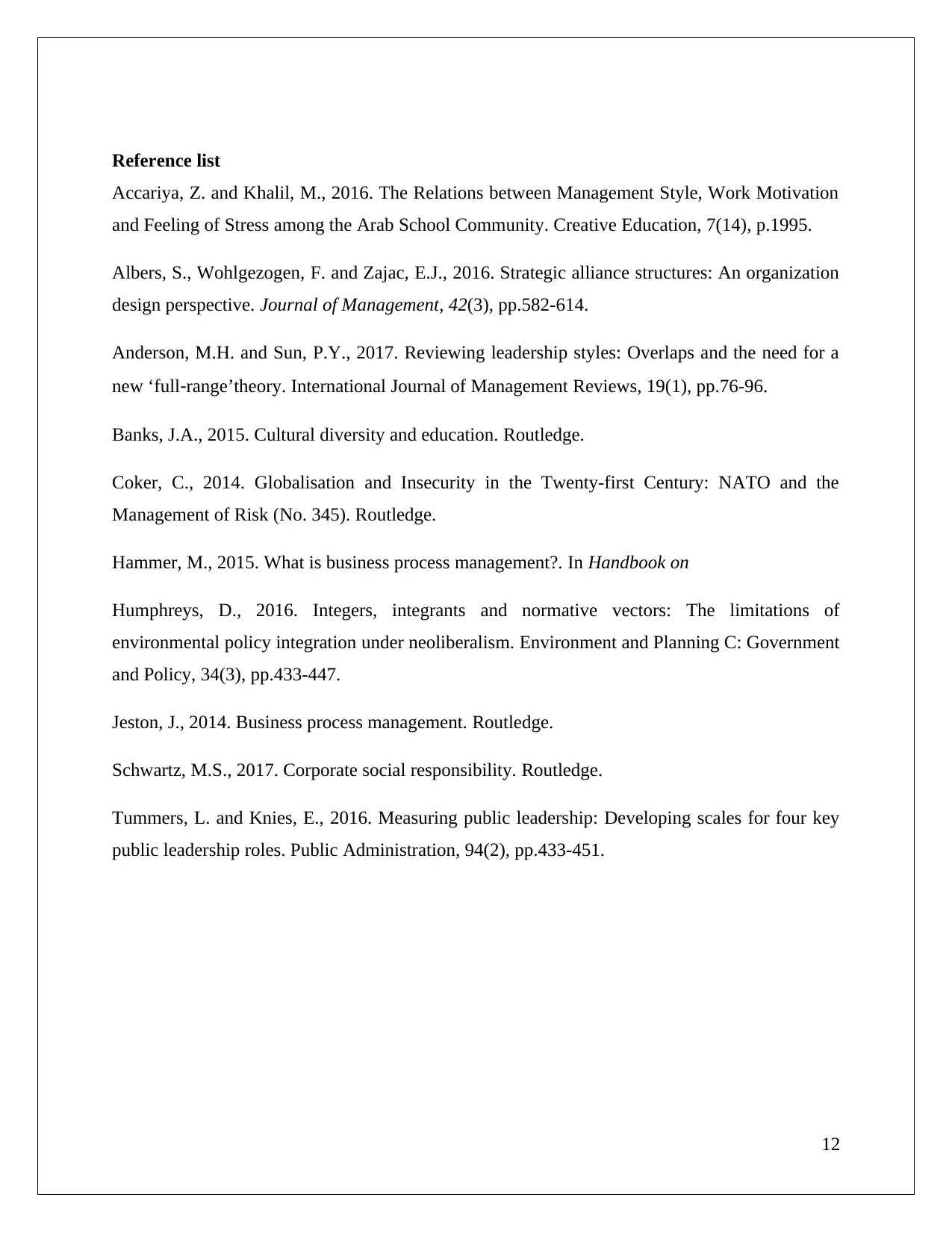
Reference list
Accariya, Z. and Khalil, M., 2016. The Relations between Management Style, Work Motivation
and Feeling of Stress among the Arab School Community. Creative Education, 7(14), p.1995.
Albers, S., Wohlgezogen, F. and Zajac, E.J., 2016. Strategic alliance structures: An organization
design perspective. Journal of Management, 42(3), pp.582-614.
Anderson, M.H. and Sun, P.Y., 2017. Reviewing leadership styles: Overlaps and the need for a
new ‘full‐range’theory. International Journal of Management Reviews, 19(1), pp.76-96.
Banks, J.A., 2015. Cultural diversity and education. Routledge.
Coker, C., 2014. Globalisation and Insecurity in the Twenty-first Century: NATO and the
Management of Risk (No. 345). Routledge.
Hammer, M., 2015. What is business process management?. In Handbook on
Humphreys, D., 2016. Integers, integrants and normative vectors: The limitations of
environmental policy integration under neoliberalism. Environment and Planning C: Government
and Policy, 34(3), pp.433-447.
Jeston, J., 2014. Business process management. Routledge.
Schwartz, M.S., 2017. Corporate social responsibility. Routledge.
Tummers, L. and Knies, E., 2016. Measuring public leadership: Developing scales for four key
public leadership roles. Public Administration, 94(2), pp.433-451.
12
Accariya, Z. and Khalil, M., 2016. The Relations between Management Style, Work Motivation
and Feeling of Stress among the Arab School Community. Creative Education, 7(14), p.1995.
Albers, S., Wohlgezogen, F. and Zajac, E.J., 2016. Strategic alliance structures: An organization
design perspective. Journal of Management, 42(3), pp.582-614.
Anderson, M.H. and Sun, P.Y., 2017. Reviewing leadership styles: Overlaps and the need for a
new ‘full‐range’theory. International Journal of Management Reviews, 19(1), pp.76-96.
Banks, J.A., 2015. Cultural diversity and education. Routledge.
Coker, C., 2014. Globalisation and Insecurity in the Twenty-first Century: NATO and the
Management of Risk (No. 345). Routledge.
Hammer, M., 2015. What is business process management?. In Handbook on
Humphreys, D., 2016. Integers, integrants and normative vectors: The limitations of
environmental policy integration under neoliberalism. Environment and Planning C: Government
and Policy, 34(3), pp.433-447.
Jeston, J., 2014. Business process management. Routledge.
Schwartz, M.S., 2017. Corporate social responsibility. Routledge.
Tummers, L. and Knies, E., 2016. Measuring public leadership: Developing scales for four key
public leadership roles. Public Administration, 94(2), pp.433-451.
12
⊘ This is a preview!⊘
Do you want full access?
Subscribe today to unlock all pages.

Trusted by 1+ million students worldwide
1 out of 12
Related Documents
Your All-in-One AI-Powered Toolkit for Academic Success.
+13062052269
info@desklib.com
Available 24*7 on WhatsApp / Email
![[object Object]](/_next/static/media/star-bottom.7253800d.svg)
Unlock your academic potential
Copyright © 2020–2025 A2Z Services. All Rights Reserved. Developed and managed by ZUCOL.




